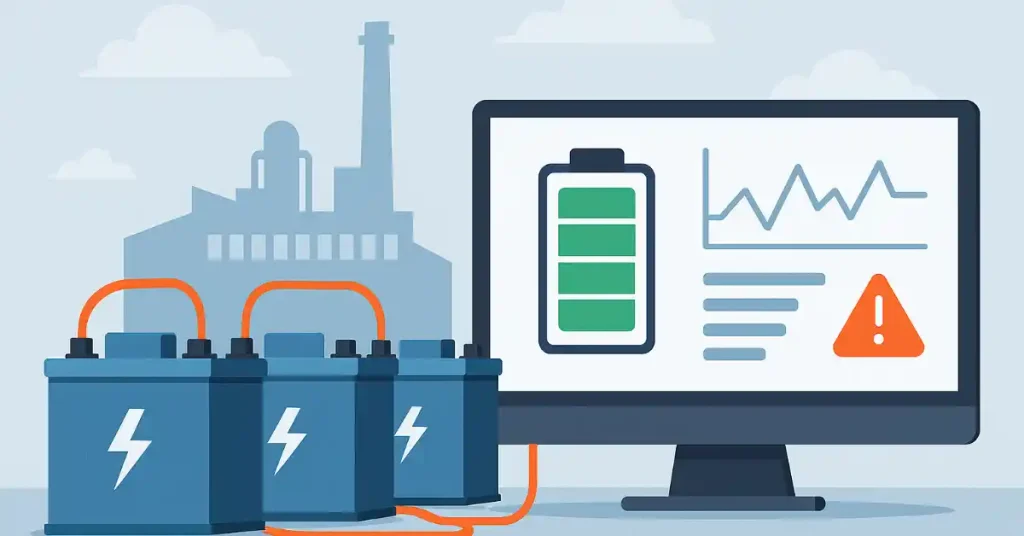In today’s industrial landscape, energy efficiency and system reliability are paramount. One key element that contributes to both is the battery system, which is often responsible for providing backup power during outages and supporting critical operations. However, as these systems age, they can develop issues that reduce their effectiveness or cause failures. This is where a battery monitoring system becomes indispensable.
BMS provides real-time insights into the health and performance of your battery assets, allowing for better management and maintenance. By integrating a BMS, you can ensure your facility’s power systems remain efficient, reliable, and cost-effective. This article explores the key benefits of implementing a battery monitoring system in your facility.
What is a Battery Monitoring System?
A battery monitoring system is a technology solution that tracks the health and performance of batteries. It continuously monitors key parameters such as voltage, current, temperature, and state of charge, among others, to determine the overall condition of the battery. This data is collected and analyzed in real-time, providing users with insights into the battery’s performance, potential failures, and the remaining lifespan.
This system is especially beneficial for facilities that rely on large-scale battery storage, uninterruptible power supplies (UPS), or renewable energy systems, where downtime could have costly or dangerous consequences.
Key Benefits of Implementing a Battery Monitoring System
1. Enhanced Battery Performance and Longevity
One of the most significant benefits of a battery monitoring system is the ability to extend the life of your batteries. Regular monitoring allows you to identify any abnormal behavior, such as undercharging or overcharging, which can lead to degradation over time.
A well-maintained battery, with optimal charging cycles, is more likely to last longer and operate at peak efficiency. The data provided by a battery condition monitoring system can help you understand when a battery is nearing the end of its life, allowing for timely replacements before failure occurs.
This proactive approach to maintenance not only improves performance but also reduces the likelihood of unexpected downtime.
2. Early Detection of Potential Failures
One of the key roles of a battery monitoring system is to detect potential failures before they happen. Batteries can develop problems that may not be immediately visible, such as reduced capacity or uneven charging.
By monitoring these parameters in real-time, the system can trigger alerts when abnormalities are detected. This allows facility managers to take action quickly, such as performing maintenance or replacing batteries before a complete failure occurs.
For example, an UPS battery monitoring system can alert you when a battery is struggling to hold a charge, preventing an unexpected outage during a critical time.
3. Improved Operational Efficiency
By integrating it into your facility, you gain the ability to optimize your energy usage. The system provides valuable insights into how your batteries are performing, helping you make data-driven decisions on when to charge or discharge them for maximum efficiency.
This information can be used to reduce energy consumption, as you can better understand when and how to use your batteries based on their current state. It ensures that your facility is only using energy when necessary, preventing waste and improving overall operational efficiency.
4. Cost Savings on Maintenance and Replacements
Maintaining a large fleet of batteries can be costly, especially when issues go undetected for long periods. Without a monitoring system, you may only discover battery problems after they have caused damage to the system, leading to expensive repairs or even complete system failures.
With a battery monitoring system in place, you can identify and address minor issues before they escalate, thus preventing costly repairs and replacements. Additionally, by identifying underperforming batteries and replacing them at the right time, you can avoid the need to replace the entire battery bank prematurely.
In the long term, this proactive approach to maintenance and management leads to significant cost savings.
5. Improved Safety and Risk Management
Battery systems, particularly those used in UPS systems and other critical operations, can pose serious safety risks if not monitored correctly. Overcharged or overheated batteries can lead to dangerous situations, such as fires or explosions.
A battery monitoring system helps mitigate these risks by tracking the temperature and charging levels of the batteries. If any parameter exceeds the recommended threshold, the system can issue an alert, allowing you to take corrective action before any safety hazard occurs.
This added layer of safety is crucial for ensuring that your facility operates without putting employees or assets at risk.
6. Real-Time Data for Better Decision-Making
The data provided by a battery monitoring system is invaluable for informed decision-making. Whether you’re assessing the performance of your backup power systems or planning for future energy needs, having accurate, real-time data is essential.
The data can be used to create reports that detail the current health of your batteries and help you plan for future upgrades or replacements. For facilities operating large-scale battery systems, the ability to make decisions based on this data is critical for long-term success.
7. Compliance with Regulatory Standards
In many industries, particularly in sectors such as healthcare, telecommunications, and data centers, there are strict regulations surrounding backup power systems. These regulations often require the monitoring of battery performance and maintenance schedules to ensure system reliability.
By implementing it, you can ensure that your facility remains compliant with these regulations. The system provides detailed logs and reports that demonstrate your commitment to maintaining optimal battery performance and safety, which can be essential during audits or inspections.
Key Takeaways
Implementing a battery monitoring system in your facility offers numerous benefits, including:
- Extended battery life and enhanced performance
- Early detection of potential failures, reducing downtime
- Improved operational efficiency and energy savings
- Cost savings through proactive maintenance and timely replacements
- Improved safety and risk management
- Access to real-time data for better decision-making
- Regulatory compliance for industries with strict standards
With all these advantages, it’s clear that a battery monitoring system is a smart investment for any facility relying on battery-powered systems. It not only ensures the reliability and efficiency of your energy systems but also protects your bottom line by minimizing unplanned outages and maintenance costs.
By choosing the right battery monitoring systems, such as those designed for UPS or other battery-powered assets, you can safeguard your operations while maximizing performance and reducing risk.
Conclusion
The decision to implement a battery monitoring system is not just about keeping your batteries running longer. It’s about optimizing your energy usage, ensuring safety, and making data-driven decisions that align with your facility’s needs.
Whether you are managing a UPS system, a backup power network, or an energy storage system, the insights provided by these systems can make all the difference in maintaining reliable, efficient, and cost-effective operations.
As battery technology continues to evolve, so too will the capabilities of monitoring systems. With more advanced systems coming to market, the future of battery management looks even more promising, providing businesses with more tools to improve operational efficiency and reduce environmental impact.





